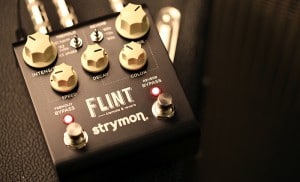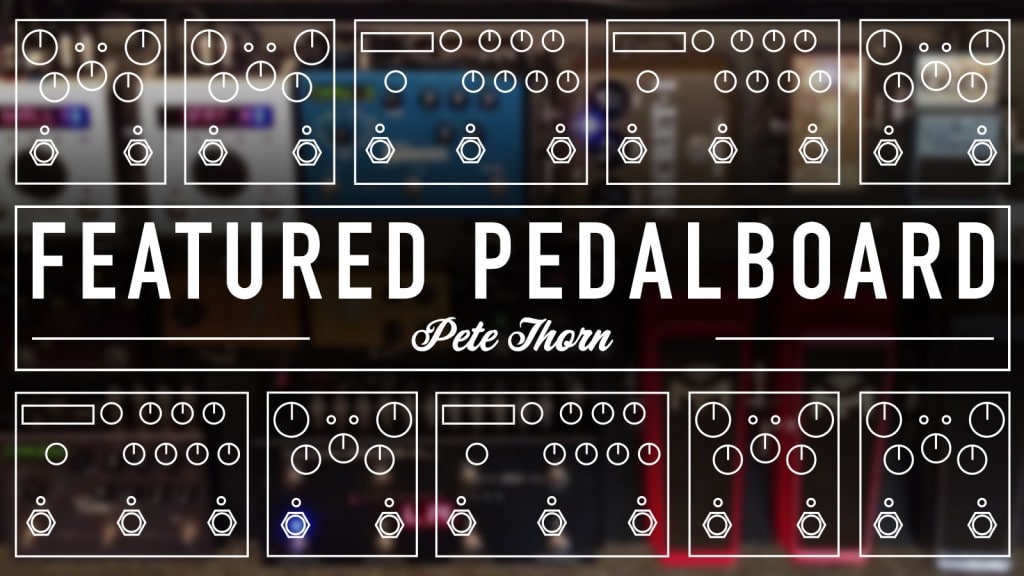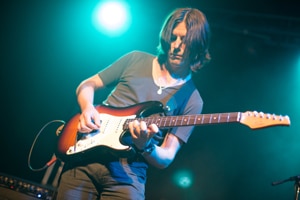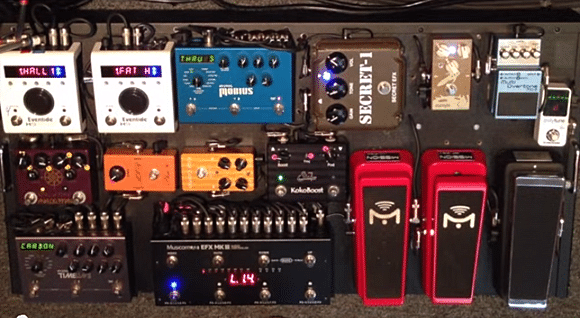
Pete Thorn’s Flint Tremolo & Reverb demo video
If you haven’t seen and heard Pete Thorn’s amazing Flint Tremolo & Reverb video demo, you’re missing out. Take a listen! Make sure to pick
Free US Shipping On Orders Over $49
Easy 30-Day Returns
Financing Available Through ![]()

 Guitarist Pete Thorn can be found doing a myriad of things. He has been guitar sideman for Chris Cornell, Don Henley, Melissa Etheridge and many more. He also has his own solo album Guitar Nerd. You can check out a bunch of great gear demos on Pete’s youtube page. Or if you are looking for some tips, be sure to check out his articles over at Premier Guitar. Let’s get to know a bit more about his pedalboard!
Guitarist Pete Thorn can be found doing a myriad of things. He has been guitar sideman for Chris Cornell, Don Henley, Melissa Etheridge and many more. He also has his own solo album Guitar Nerd. You can check out a bunch of great gear demos on Pete’s youtube page. Or if you are looking for some tips, be sure to check out his articles over at Premier Guitar. Let’s get to know a bit more about his pedalboard!
What type of pedalboard is this?
The board is made by Trailer Trash, and I use it for touring and for recording. It’s big enough to do everything I could possibly want, but small enough that I can still carry it around myself— fits nicely in the trunk of my car!
What is your signal path?
My guitar either feeds an AKG wireless, then the pedalboard, or is plugged into the board using Providence cable. The signal runs into a Mission volume pedal and Vertex Axis wah, then hits the Musicomlab MKIII switcher. The switcher feeds a TC Polytune mini. The loops in the switcher have 8 pedals (1 per loop). They are:
The output of the switcher feeds a 1/4 inch jack on the left side of the board. Under the board is an RJM Y-Not midi A/B box, and the input and A/B outs also show up on the left side of the board. I patch the output of the switcher into the input of the A/B box. Output A feeds a D.I. This is for acoustic. Output B goes to the input of my main Suhr PT100 amp (my signature Suhr 100 watt amp). The amp effects send goes to the “post fx input”, also on the left side of my board. From there, the signal goes:
The outputs of the 2nd H9 feed the effect return of the main PT100 amp and also a 2nd PT100, for stereo. I come out of the amps into 2 Suhr 2-12″ cabs with Celestion Creamback H speakers. That’s it!

What things did you need to take into consideration when building your 2014 pedalboard?
Size. I wanted it to be small enough to carry myself! But yet, I wanted to be able to do virtually everything I did with my previous rig—which consisted of a 12 space rack, 3 speaker cabs, etc etc! I need it super-reliable and road worthy. And of course NO tone suck, and as little noise as possible. On my last tour, we had to run about 35 feet of cable between the board for every run—the amps were back by my tech, but I was up on a riser. So, 35 feet from switcher out to the amp input, then 35 foot runs to and from the effects loops of the 2 heads. That’s a lot of unbalanced cable! It was quiet and sounded great, virtually like I was plugged right into the amp with a short cable. That’s because Dave Friedman did the board right, and John Suhr makes the best effect loops on earth. Buffered, quiet, tight, solid. Quality.
You tour with many artists, what is the pedal decisions like when you start touring with an artist? Does the artist provide any feedback on those decisions?
Not usually. I usually know what to do. “Black Hole Sun”…. I need a rotary pedal! “Like A Stone”- I need a whammy. That sort of thing. That’s why you get hired—you know what to do.
Please tell us about your new solo release “The Groomed Noodler.”
I recorded that track as a way to help the Suhr guys show off their new SL67 plexi-type amp. I wanted it to be just a raw, in your face kinda tune, to really show off the amp. It sounded really cool, so I decided I’d throw it up on iTunes, and also offer it through Jamtrackcentral.com as a lesson. You can get it from them as a package with full tab, a version with no lead guitar, etc. I’m glad people dig it.
How is touring solo different than touring as “guitar sideman”? Do you do anything different with your pedalboard?
Not really—the board is so versatile. I can use it easily in different configurations, in mono, or stereo, for example. I can also quickly patch everything so all the effects are in front of an amp—useful if I had to use a rental amp like a Twin or AC30, and there was no effects loop. I designed it to be adaptable to different situations.
Any advice to other musicians on what to consider when building a touring pedalboard?
I recommend collecting all the pedals first, laying them all out—look at what you have, and measure. Then you know how big of a board you’ll need. I like the Trailer Trash boards because it’s easy to run power supplies and cables underneath. It saves space and makes for a clean setup. You can also put jacks/patch points on the side of the board. I recommend that, because you can do it like I did—put some patches there, so you can re-route things easily and re-configure how you use your board, if need be. On my first tour with the board, with Melissa Etheridge, the out of the switcher fed the input of the post FX path, and the out of the last post FX (then a Line 6 M9) fed the RJM A/B box. The A out went to a Him Kelley amp set clean. The B out went to a Suhr SL68 set crunchy. So I used all FX in front, and A/B’d 2 amps, old school. Now, I use the post FX (the time based stuff) in the loop of the PT amps and am running in stereo, and the A/B is used for switching between acoustic and electric. Easy, and painless, to configure the board both ways, because of the patching on the side. So I recommend that sort of setup.
Also—I recommend consulting someone who knows this stuff really well, when building a board. There’s so many snafus you can hit, with ground loops, power issues, etc. Dave Friedman really knows his stuff, so he keeps my boards running smooth and quiet. That experience is invaluable. I can hit the stage with peace of mind, knowing my rig is tight. Good luck guys, happy rocking!
Subscribe to our newsletter to be the first to hear about new Strymon products, artist features, and behind the scenes content!

If you haven’t seen and heard Pete Thorn’s amazing Flint Tremolo & Reverb video demo, you’re missing out. Take a listen! Make sure to pick

Pete Thorn (guitarist with Melissa Etheridge, Chris Cornell, Don Henley, and many others) just put together this killer TimeLine demo. Check it out! And be

Pete Thorn, guitarist for Melissa Etheridge, Chris Cornell and Don Henley, recently put together a very cool El Capistan dTape Echo video demo. He’s only
4 Responses
Love this board – One thing I didn’t see that i was very interested in because of the H9’s and strymon’s mostly was how this was all being powered?
Thanks,
Glenn
Hi Glenn, On Pete Thorn’s YouTube comments he mentions that he is using G LAB power 🙂 Thanks!
Thanks so much for this article… I used it as a blueprint to build my board. The signal path detailed on Pete’s board was priceless to me … Pete’s pedal selection assisted me greatly as well as his pedal demo’s on youtube. I used a 36 x 18 inch Trailer Trash board also which was needed to fit all of my pedal selections. Additionally, his use of the RJM Y-Not proved to be genius with regard to an additional output from the board … my board’s Y-Not Out B is used as an either / or output for acoustic DI or Harmonica output to a harp amp. Had it not been for this article, I would have traveled far down the wrong path during this DIY project … if you’re considering building own board, study Pete’s board thoroughly and take heed to his advise with acquiring all your pedals prior to starting … again, many thanks for this article.
… oh yea, I forgot to mention … I have the Big Three Strymons on my board … and, they’re absolutely awesome!